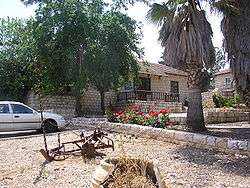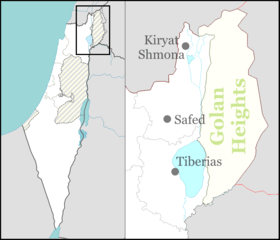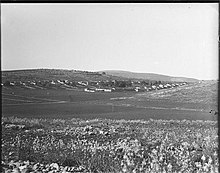Ilaniya
Ilaniya (Hebrew: אִילָנִיָּה) is a moshav in northern Israel. Also known as Sejera, after the adjacent Arab village al-Shajara, it was the first Jewish settlement in the Lower Galilee and played an important role in the Jewish settlement of the Galilee from its early years until the 1948 Arab–Israeli War. It falls under the jurisdiction of Lower Galilee Regional Council, and had a population of 490 in 2018.[1]
Ilaniya אִילָנִיָּה | |
|---|---|
 | |
 Ilaniya | |
| Coordinates: 32°45′30″N 35°24′7″E | |
| Country | Israel |
| District | Northern |
| Council | Lower Galilee |
| Affiliation | Agricultural Union |
| Founded | 1899 |
| Founded by | Jewish Colonization Association |
| Population (2018)[1] | 490 |
History
Byzantine period
A Jewish town was located in the surrounding hills during the period of the Talmud and Mishnah.
Zionist settlements

The agricultural colony of Sejera, later Ilaniya, was established in 1900-1902 on land purchased by Baron Edmond James de Rothschild which was transferred to the management of the Jewish Colonization Association (JCA/ICA) in 1899. Also in 1899, JCA bought additional land for its planned colony. The first settlers were residents of Safed, a group of immigrants from Kurdistan and eight families of Subbotniks, Russian Christians who had converted to Judaism, among them the Dubrovin family.[2]
The small settlement founded by JCA had two sections, a sharecroppers' colony for more experienced farmers, and a training farm for unskilled workers. The former consisted of a short street with private houses on both sides with garden plots in front and sheds at the back.
The training farm was located slightly higher up the slope, with a yard enclosed by a wall and single rooms for workers. The overall concept came from JCA official Chaim Margalioth Kalvarisky. The JCA's purpose was to help settle the land with professional Jewish farmers, agriculture being seen as a morally as well as economically sound activity. Unwilling to run their project as a charity organisation in the style of Baron de Rothschild, the JCA leaders in Paris expected the training farm to be self-sufficient and to generate profit. When this did not happen, they replaced Kalvarisky in 1901 with the young agronomist Eliyahu Krause. Since the farm continued losing money, the JCA started in 1906 a process of reducing the administered training farm and gradually transferring its allocated land to the sharecroppers.
In 1907-1908, a socialist commune led by Manya Wilbushewitch and Israel Shochat was contracted to run the farm autonomously for one year, without administrative interference. Wilbushewitch received the support of Yehoshua Hankin, who brought in Eliahu Krause to design an operative plan. The eighteen commune members, young men and women from Sejera and elsewhere in Palestine, aided by a number of sympathisers, managed for the first time to generate a profit and ensure constant employment for all workers of Sejera (with the side effect that outside Arab workers were no longer needed), while also pioneering full equality for women. Along with their work in agriculture there were daily educational meetings where they learned Hebrew from the young David Grün, the future prime-minister of Israel David Ben-Gurion, Arabic from an Arab villager, socialist theory from Manya Wilbushewitch, and the latest news from Israel Shochat. Less publicly, the group used Sejera for training the newly constituted Bar-Giora Jewish self-defense organisation, which eventually took over from Circassians and Arabs the guarding duties in Sejera and other nearby Jewish settlements. Manya Wilbushewitch and Israel Shochat married in Sejera in 1908.[3]
Despite the economic success, JCA did not renew the agreement with the socialist commune at the end of the one-year experiment. By taking what was one of the least profitable ranches in the land and making it profitable, Manya Shochat showed that her ideas for a communal collective could work. This first well-run socialist-Zionist commune in Palestine is counted as an important precursor of the kibbutz movement and one of the nuclei of Jewish rural settlement in Palestine.
By 1912-1913, the training farm was closed down, its land reallocated to the sharecroppers or sold to a Jewish plantation company. Still, after over a decade of teaching essential skills to agricultural workers, and by bringing together some of the leading pioneers of the First and Second Aliyah who would go on to establish the infrastructure of the pre-state Zionist society, the farm can be said to have played an essential role in the Zionist enterprise.[4]
During the 1948 Arab–Israeli War the village was attacked several times by the Army for the Liberation of Palestine, led by Fawzi al-Qawuqji.[5] Most of the Jewish inhabitants temporarily abandoned the place, while the remaining ones took part in the fighting. By 1949 the settlement expanded and included the territory of the adjacent Palestinian Arab village of al-Shajara, which had been depopulated during the war.
At some point Ilaniya became a moshav.
Landmarks
Ilaniya and the Sejera farm are on the list of conserved sites. Some places of note are the old school, founded in 1922; the mikveh tahara in a sepulchral grotto; the house of Naftali Fabrikant, now a library and educational centre; and the ruins of a synagogue from the Byzantine era.
Notable residents
- David Ben Gurion[6]
References
- "Population in the Localities 2018" (XLS). Israel Central Bureau of Statistics. 25 August 2019. Retrieved 26 August 2019.
- The first settlement in the Lower Galilee Archived 2013-10-18 at the Wayback Machine
- The Jewish Connection, Phyllis Appel
- The first settlement in the Lower Galilee Archived 2013-10-18 at the Wayback Machine
- The Birth of the Palestinian Refugee Problem Revisited, Benny Morris
- God, Guns and Israel: Britain, The First World War And The Jews in the Holy City, Jill Duchess of Hamilton, Jill Hamilton
| Wikimedia Commons has media related to Ilaniya. |
Further reading
- HaReuveni, Immanuel (1999). Lexicon of the Land of Israel (in Hebrew). Miskal - Yedioth Ahronoth Books and Chemed Books. p. 33. ISBN 978-965-448-413-8.
- ed. Yuval Elazari - Map's Concise Gazetteer of Israel Today MAP - Mapping and Publishing, Tel Aviv, 2003 (in Hebrew)
- Ran Aharonson (2000). Rothschild and Early Jewish Colonization in Palestine. Rowman & Littlefield Publishers. pp. 282–283.
- Neville J. Mandel (1977). Arabs and Zionism Before World War I. University of California Press. pp. 67–70.
- Derek Jonathan Penslar (1991). Zionism and Technocracy: The Engineering of Jewish Settlement in Palestine, 1870-1918. Indiana University Press. pp. 29–33.
- Paul R. Mendes-Flohr; Jehuda Reinharz, eds. (2010). The Jew in the Modern World: A Documentary History. Oxford University Press. p. 565.
- Shulamit Reinharz (1992). "The winding road to Sejera". In Deborah S. Bernstein (ed.). Pioneers and Homemakers: Jewish Women in Pre-State Israel. State University of New York Press. pp. 95, 105–116.